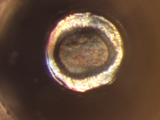Washington, D.C. — Although its name may make many people think of flowers, the element germanium is part of a frequently studied group of elements, called IVa, which could have applications for next-generation computer architecture as well as implications for fundamental condensed matter physics.
New research conducted by Xiao-Jia Chen, Viktor Struzhkin, and Ho-kwang (Dave) Mao from Geophysical Laboratory at Carnegie Institution for Science, along with collaborators from China, reveals details of the element’s transitions under pressure. Their results show extraordinary agreement with the predictions of modern condensed matter theory.
Germanium (atomic number 32) is used in fiber-optic systems, specialized camera and microscope lenses, circuitry, and solar cells. Under ambient conditions it is brittle and semiconducting. But under pressure, the element should exhibit superconductivity, meaning that there is no resistance to the flow of an electric current.

This image shows nanocrystalline germanium with hydrogen serving as pressure medium. Image credit: Carnegie Institution for Science
The team’s research, published in Physical Review Letters, discovered that under pressure of 66 GPa (about 650,000 atmospheres), germanium undergoes a structural change from one type of solid material to another that is metallic—meaning it conducts electricity. It then undergoes another structural change under pressure of 90 GPa (about 890,000 atmospheres). These findings matched theoretical predictions about the element’s behavior under extreme pressure.
“A series of phase transitions was observed on compression of germanium that creates structures with increased density,” Chen said. “We found extraordinary agreement between theory and experiment for the structures, energies, and compressional behavior. Though some of this behavior had been noted earlier, the agreement between the new highly accurate experimental results and theory really was quite remarkable.”
The team’s results show that superconductivity in this simple element is caused by phonons, or collective vibrations in the crystal structures that germanium assumes under pressure.
*Source: Carnegie Institution for Science
